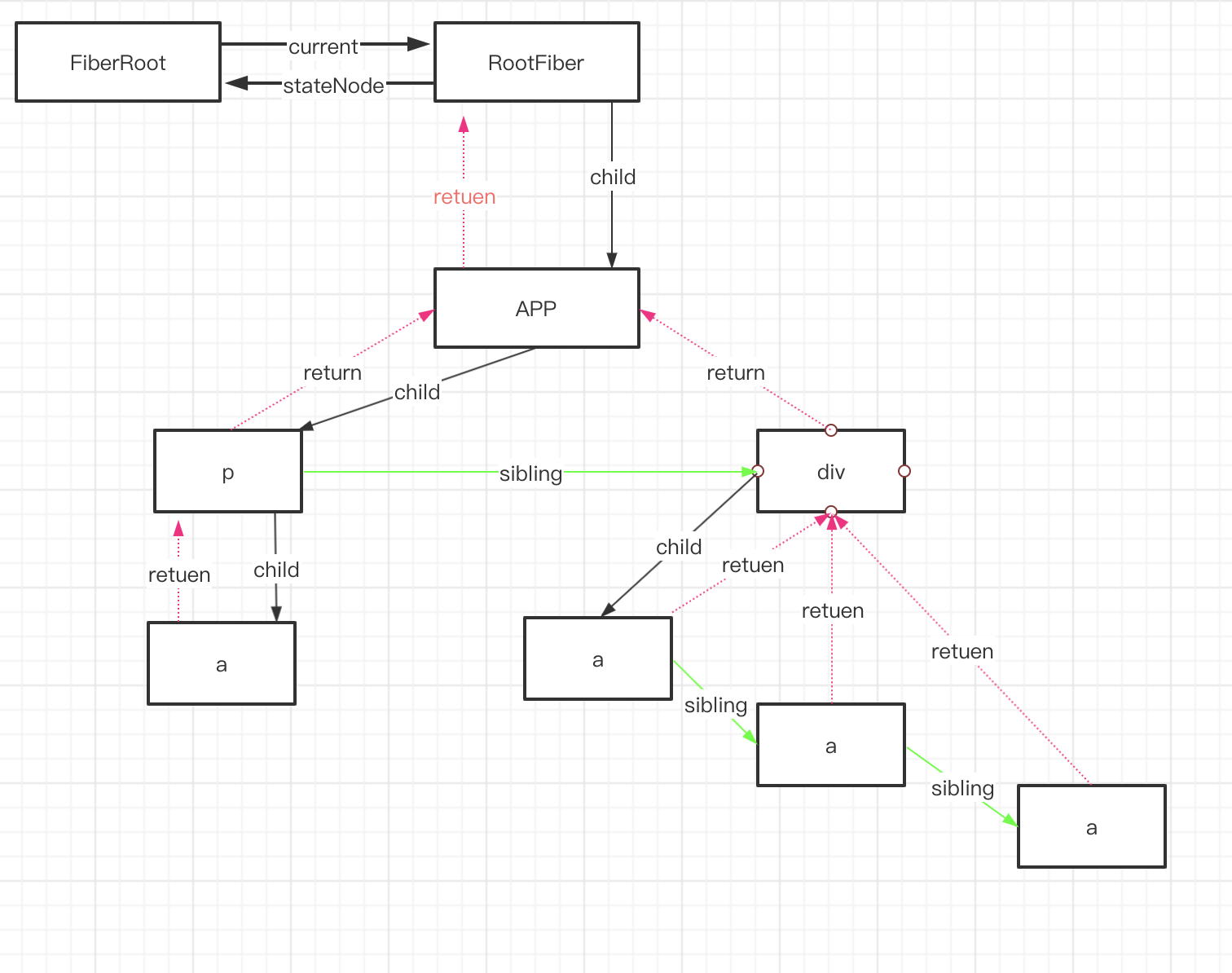# completeUnitOfWork
上面我们分析完了 beginWork 接下来会调用 completeUnitOfWork
function performUnitOfWork(workInProgress) {
let next = beginWork(current,workInProgress)
if (next === null) {
next = completeUnitOfWork(workInProgress)
}
return next
}
# completeUnitOfWork
completeUnitOfWork 主要做以下几件事情:
创建DOM对象
递归处理子树的DOM对象
把创建的dom 对象赋值给 workInProgress.stateNode 属性
设置DOM 对象的属性 绑定事件
把子节点的 sideEffect 添加到父节点上
基于上面我把代码简化了下 大体思路如下,可以自行查看源码 completeUnitOfWork
function completeUnitOfWork(workInProgress) {
while (true) {
// 创建 dom 节点
next= completeWork(workInProgress)
// 存在新的Fiber节点,退出循环, 回到performUnitOfWork阶段
if (next !== null) {
// Completing this fiber spawned new work. Work on that next.
return next;
}
let effectTag = workInProgress.effectTag
...
let returnFiber = workInProgress.return
let siblingFiber = workInProgress.sibling
// 把所有子Fiber节点的effects和当前Fiber的effects添加到父节点的effect队列当中去
if (returnFiber.firstEffect === null) {
returnFiber.firstEffect = workInProgress.firstEffect;
}
if (workInProgress.lastEffect !== null) {
if (returnFiber.lastEffect !== null) {
returnFiber.lastEffect.nextEffect = workInProgress.firstEffect;
}
returnFiber.lastEffect = workInProgress.lastEffect;
}
// 看是否存在同级的兄弟Fiber节点,如存在,则退出completeUnitOfWork阶段,回到beginWork里去
if (!!siblingFiber) return siblingFiber
if (!!returnFiber) {
workInProgress = returnFiber
continue
}
return null
}
}
逻辑什么意思呢?我们知道 React fiber 的 child 只会关联一个,那我们有多个子节点怎么办呢?这个时候就会用到 sibling 属性来关联,最后子节点的 return 都会指向父节点,对应我们之前的那张图

因此 React 会首先进行 从上到下 创建 fiber 节点,然后再从下到上生成 DOM节点,我们在上面逻辑可以看到,首先调用 completeWork 传入 workInProgress 创建 DOM 节点,然后会判断有没有兄弟节点,然后返回兄弟节点,那么又会回到 beginWork 创建 Fiber 节点,然后本节点创建完了 就会去判断有没有父节点 然后再去生成 DOM, 如同我们前面的 例子
👺
这里不得不感慨,React 这设计真的巧妙啊!!!
这样一来,流程基本就串起来了,生成 Fiber树->生成DOM树,接下来看生成 DOM的方法 completeWork
# completeWork
completeWork 会根据 workInProgress.tag 走不同的分支
function completeWork(
current: Fiber | null,
workInProgress: Fiber,
renderExpirationTime: ExpirationTime,
): Fiber | null {
const newProps = workInProgress.pendingProps;
switch (workInProgress.tag) {
case IndeterminateComponent:
case LazyComponent:
case SimpleMemoComponent:
case FunctionComponent:
case ForwardRef:
case Fragment:
case Mode:
case Profiler:
case ContextConsumer:
case MemoComponent:
return null;
case ClassComponent: {
const Component = workInProgress.type;
if (isLegacyContextProvider(Component)) {
popLegacyContext(workInProgress);
}
return null;
}
...
// 创建DOM对象
case HostComponent: {
...
}
// 创建文本
case HostText: {
...
}
}
我们主要看 HostComponent,因为它是原生HTML元素。
# HostComponent
case HostComponent: {
popHostContext(workInProgress);
const rootContainerInstance = getRootHostContainer();
const type = workInProgress.type;
if (current !== null && workInProgress.stateNode != null) {
updateHostComponent(
current,
workInProgress,
type,
newProps,
rootContainerInstance,
);
if (enableDeprecatedFlareAPI) {
const prevListeners = current.memoizedProps.DEPRECATED_flareListeners;
const nextListeners = newProps.DEPRECATED_flareListeners;
if (prevListeners !== nextListeners) {
markUpdate(workInProgress);
}
}
if (current.ref !== workInProgress.ref) {
markRef(workInProgress);
}
} else {
if (!newProps) {
return null;
}
const currentHostContext = getHostContext();
// TODO: Move createInstance to beginWork and keep it on a context
// "stack" as the parent. Then append children as we go in beginWork
// or completeWork depending on whether we want to add them top->down or
// bottom->up. Top->down is faster in IE11.
let wasHydrated = popHydrationState(workInProgress);
if (wasHydrated) {
// TODO: Move this and createInstance step into the beginPhase
// to consolidate.
if (
prepareToHydrateHostInstance(
workInProgress,
rootContainerInstance,
currentHostContext,
)
) {
// If changes to the hydrated node need to be applied at the
// commit-phase we mark this as such.
markUpdate(workInProgress);
}
if (enableDeprecatedFlareAPI) {
const listeners = newProps.DEPRECATED_flareListeners;
if (listeners != null) {
updateDeprecatedEventListeners(
listeners,
workInProgress,
rootContainerInstance,
);
}
}
} else {
// 创建Dom对象
let instance = createInstance(
type,
newProps,
rootContainerInstance,
currentHostContext,
workInProgress,
);
// 把子树中的DOM对象append到本节点的instance之中
appendAllChildren(instance, workInProgress, false, false);
// This needs to be set before we mount Flare event listeners
workInProgress.stateNode = instance;
if (enableDeprecatedFlareAPI) {
const listeners = newProps.DEPRECATED_flareListeners;
if (listeners != null) {
updateDeprecatedEventListeners(
listeners,
workInProgress,
rootContainerInstance,
);
}
}
// 设置DOM对象的属性, 绑定事件等
if (
finalizeInitialChildren(
instance,
type,
newProps,
rootContainerInstance,
currentHostContext,
)
) {
markUpdate(workInProgress);
}
}
if (workInProgress.ref !== null) {
// If there is a ref on a host node we need to schedule a callback
markRef(workInProgress);
}
}
return null;
}
下章我们具体看下创建 DOM 的过程
← ClassComponent DOM创建 →